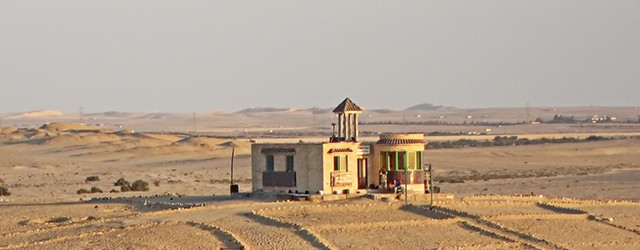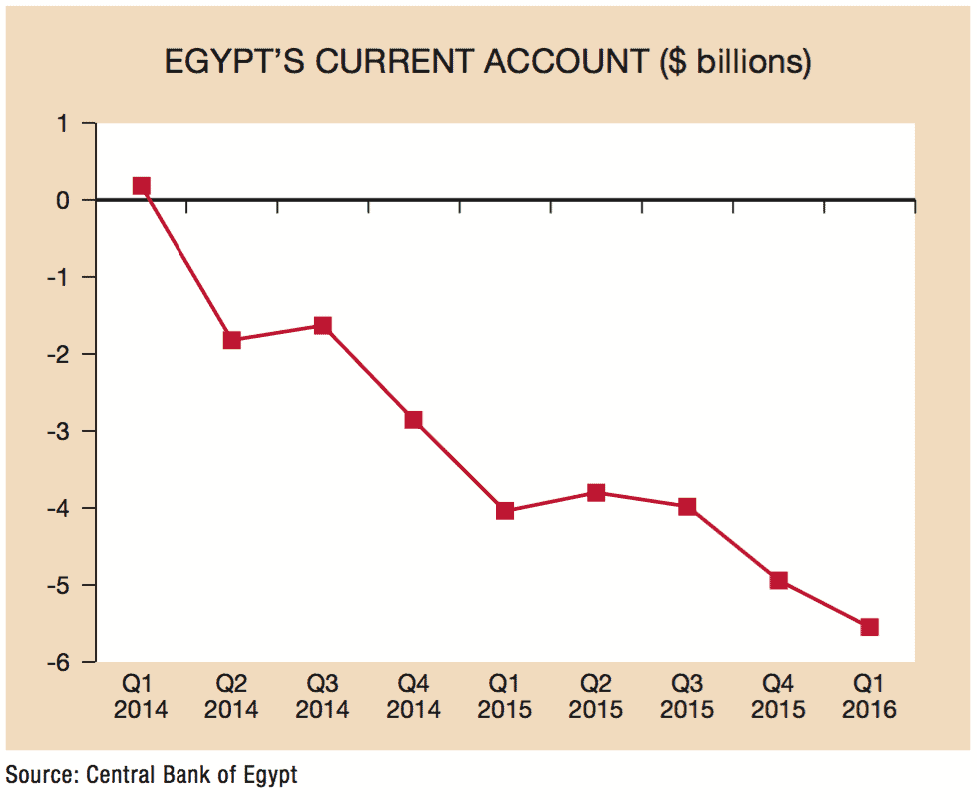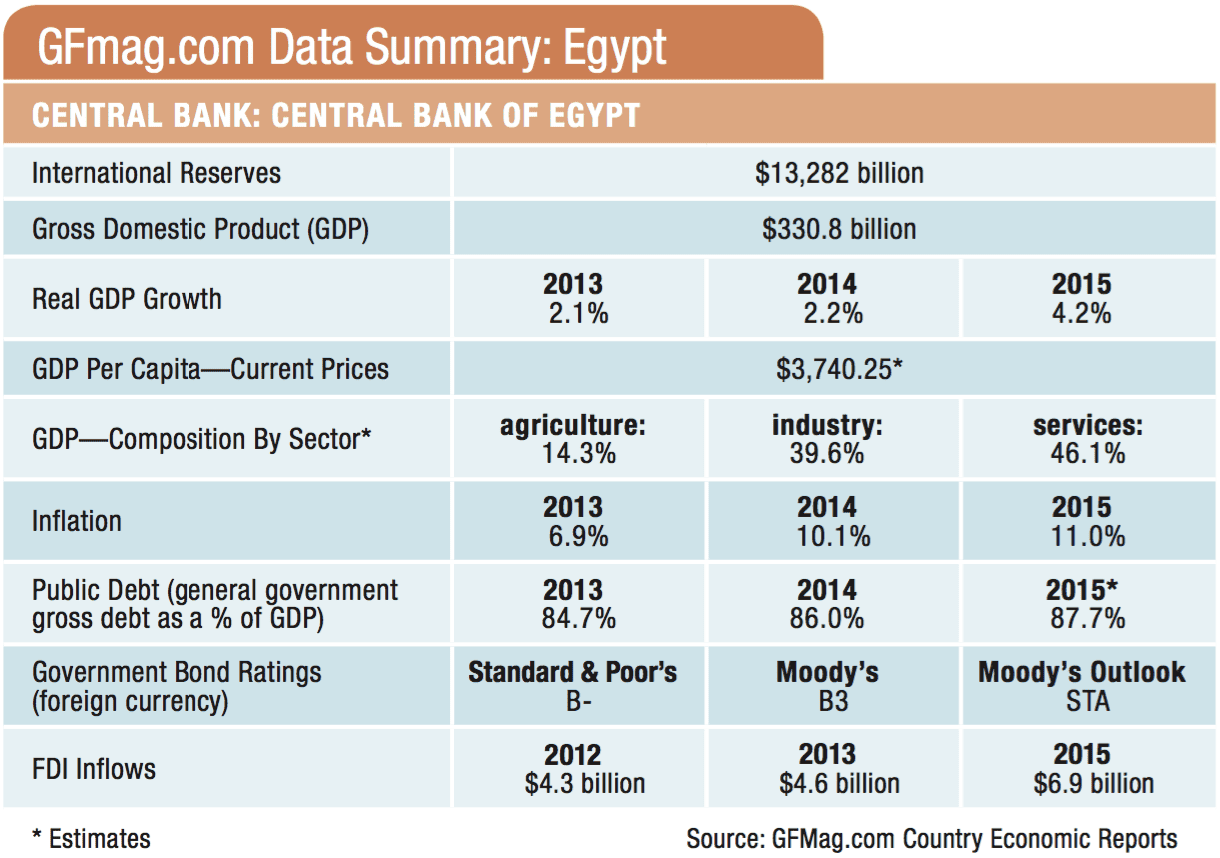Its IMF loan could ease investor concerns and end its foreign exchange shortage.


Egypt’s decision to pursue a $12 billion loan from the International Monetary Fund and implement tough reforms will put the most populous country in the Arab world on a path toward stronger, more sustainable growth, economists say. This is good news for the country’s 90 million people, who have suffered rising unemployment and inflation since the Arab Spring uprising of 2011.
“An IMF [preliminary] deal is finally in place; buckle up for structural adjustment,” says Mohamed Abu Basha, vice president, economics, in the research division at EFG-Hermes, a Cairo-based investment bank. “While the impact of the expected reforms may worsen inflationary pressures in the short term, we clearly see the agreement as a cornerstone for restoring macroeconomic stability.”
Egypt is running low on foreign exchange reserves but has managed to remain solvent with help from the oil-producing nations of the Gulf Cooperation Council. The aid from its Gulf allies won’t continue indefinitely, however, particularly with low oil prices straining GCC-member budgets.
A three-year, $12 billion loan program with the IMF will help bridge a funding gap of $21 billion in the same period, according to Basha. A final agreement could be reached in mid-September, following the expected implementation of a value-added tax, and ratification by the IMF board and the Egyptian parliament, he says.
The government plans to capitalize on the expected signing of the loan accord, and the introduction of reforms, to access international bond markets, with a $2 billion to $3 billion eurobond issuance in September or October, according the Finance Ministry. Egypt also has access to a $3 billion World Bank loan and a $1 billion loan from the African Development Bank.

“An IMF financing package, if it materializes, would help improve Egypt’s external financing requirement and improve the economy’s growth prospects,” says William Jackson, senior emerging markets economist at Capital Economics. The hope is that the conditions attached to IMF funding will also support a pickup in private capital inflows, he says.
Strains in Egypt’s balance of payments have persisted since 2011. As capital flows dried up, the Central Bank of Egypt was forced to burn through its foreign exchange reserves to maintain a tight grip on the Egyptian pound.
The IMF has long urged the Egyptian government to push ahead with subsidy cuts, as well as to shift to a more flexible exchange rate. The government already has cut some energy subsidies, and the central bank devalued the pound by 12.5% against the dollar in March. A further devaluation is likely, according to Jackson. A weaker currency will help to boost the competitiveness of exports and attract private capital back into the country.
“An IMF agreement would enable the central bank to remove some restrictions on access to foreign exchange that have disrupted economic activity,” Jackson says. The government also plans to sell stakes in banks and other companies to stimulate the equity market and revive investor interest.
Meanwhile, development of the enormous Zohr gas field in the deep offshore Mediterranean Sea could portend a brighter economic future for Egypt in the medium term, with less pressure from external payments. “We expect Zohr to be one of the main factors behind future growth,” Jackson says.

Italian energy giant Eni plans to invest up to $5 billion to develop Egypt’s oil and gas reserves in the next few years. In February 2016, Eni was awarded a development lease at the Zohr field, which is estimated to hold 30 trillion cubic feet of gas. Zohr could grant energy independence to Egypt for many years to come, Eni says. Global energy and mining consultancy Wood Mackenzie says it expects Zohr to be the biggest project sanctioned globally this year, with an estimated budget of more than $14 billion. The first gas is expected to flow at the end of 2017.
Meanwhile, Saudi Arabia has agreed to finance Egypt’s oil needs for the next five years as part of a $22 billion aid package. On a visit to Cairo in April, King Salman bin Abdulaziz of Saudi Arabia agreed with Egyptian president Abdel Fattah el-Sisi to build a $4 billion bridge across the Red Sea entrance of the Gulf of Aqaba connecting the two countries. The causeway would pass through Tiran Island, one of two islands Egypt ceded to Saudi Arabia, and would link the Tabuk region of northeastern Saudi Arabia with the Egyptian resort of Sharm el-Sheikh on the Sinai Peninsula.
The Saudi aid package also includes funding to expand Egypt’s power generation capacity and $1.5 billion for economic development of the Sinai, one of Egypt’s urgent goals in the face of an ongoing insurgency by Islamist militants in the region.
Tenders will be held in December for a $1.6 billion project to link Saudi Arabia and Egypt’s power grids. The project would allow the countries to share an additional 3,000 megawatts of electricity during peak demand periods.
Fuel supplies from GCC nations have enabled Sisi to sharply reduce power blackouts and to demonstrate some effectiveness in straightening out the country’s economic and infrastructure problems. Nevertheless, heightened security concerns after EgyptAir flight 804 from Paris to Cairo plunged into the Mediterranean Sea in May have caused tourist arrivals to collapse to the lowest level in a decade, worsening the shortage of foreign currency. In October 2015, a Russian Metrojet exploded over the Sinai after taking off from Sharm el-Sheikh, killing 224 people. Russia is Egypt’s largest source of tourist arrivals.
The contribution of travel and tourism to employment in Egypt, including jobs indirectly supported by the industry, was 10.5% of the country’s total employment last year, according to the World Travel & Tourism Council. President Sisi recently designated the new Grand Egyptian Museum at the pyramids in Giza as a priority project, hoping to attract more tourists.

Meanwhile, remittances from Egyptians working abroad are falling sharply, reflecting a slowdown in the GCC countries. Suez Canal revenues have also declined, despite the country’s massive investment in expanding the canal. Egypt’s budget deficit in the fiscal year ended June 30, 2016, was 11.5% of GDP.
In announcing in late July that Egypt was close to signing a deal with the IMF, Sisi stressed “the importance of cooperation with the IMF through the support program to enhance international confidence in the economy and attract foreign investment, and therefore achieve monetary and financial stability.”
Attracting FDI will also depend on creating a more welcoming business environment, economists say. Egypt ranks 131st out of 189 countries in the World Bank’s latest Doing Business Survey. “Egypt scores poorly on issues such as the enforcement of contracts, dealing with construction permits, paying taxes, and is one of the lowest-ranked countries in the world for investor protection,” according to a report by Capital Economics. The government has taken some steps to address these issues, but more work needs to be done, it says.
Hassan Abdalla, CEO and vice chairman of Cairo-based Arab African International Bank, says AAIB has grown its earnings by a compound annual rate of 11% since the financial crisis of 2008. “True, we have a dynamic socioeconomic landscape in Egypt, but this is still a growing economy with lots of potential,” he says. “Challenges are acknowledged but are not showstoppers.”
With its diversified economy, deep market and young and skillful human resources, Egypt has all the credentials for success, Abdalla says. The opportunities are particularly large in the banking industry, he adds, since there is only one bank branch for every 23,600 people.
AAIB is focused on growing its network of 90 branches and enhancing its self-service channels to reach more customers, according to Abdalla. AAIB was also the first Egyptian bank to establish a presence in the Gulf region, in the early 1970s. “Our strong presence in the Gulf area gave us an edge in attracting foreign investors to Egypt,” Abdalla says. “We managed to attract strategic investors who are interested in the Egyptian equity market, generating foreign currency sources.”
Abdalla also sees potential in lending to small and medium-size enterprises. “Being proficient in soliciting opportunities for growth, we can no longer miss on this segment,” he says. “SMEs represent a big portion of Egypt’s GDP and are a dynamic force for sustained economic growth and job creation, but many are still facing problems in finding access to finance and banking services.”

Lending to SMEs will help to diversify the bank’s loan portfolio and create new revenue streams, Abdalla believes. “Microfinance is another new segment that we are targeting, and we shall shortly launch ‘Sandah’ in association with Sanad, a fund initiated in association with Germany’s KfW Development Bank,” he says.
Profit for Egypt’s banks will likely remain strong, with the sector’s return on average equity at 18.9%, according to Moody’s Investors Service. The banks will benefit from their high exposure to high-yielding sovereign debt, as well as from rising interest rates and new central bank regulations allowing banks to finance certain SME loans from their reserves, along with high lending volumes, Moody’s says.
Although an Egypt-IMF deal would be a positive step for the economy, past negotiations between Egypt and the fund have been notoriously difficult. “So, for now, we are not taking anything for granted,” says Jason Tuvey, Middle East economist at Capital Economics.



